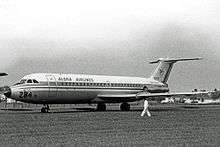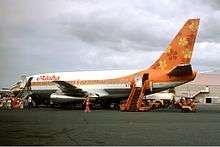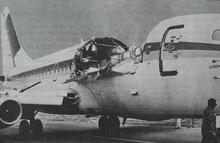Aloha Airlines
 | |||||||
| |||||||
| Founded | July 26, 1946 (as Trans-Pacific Airlines)[1] | ||||||
|---|---|---|---|---|---|---|---|
| Commenced operations | July 26, 1946 | ||||||
| Ceased operations | March 31, 2008 (All operations transferred to Aloha Air Cargo for cargo flights) | ||||||
| Hubs | Honolulu International Airport | ||||||
| Secondary hubs | John Wayne Airport | ||||||
| Frequent-flyer program | AlohaPass | ||||||
| Airport lounge | Aliʻi Club | ||||||
| Alliance | Island Air, United Airlines | ||||||
| Subsidiaries | Aloha Air Cargo, Aloha Island Air, Aloha Pacific Air | ||||||
| Fleet size | 22 | ||||||
| Destinations | 20 | ||||||
| Company slogan | Expect More [2] | ||||||
| Parent company | Aloha Air Group | ||||||
| Headquarters | Honolulu, Hawaii | ||||||
| Key people | Ruddy Tongg (Co-Founder), Richard C Tongg (Co-Founder), David Banmiller (President & CEO) | ||||||
| Website | alohaairlines.com | ||||||
Aloha Airlines was a Hawaiian airline headquartered in Honolulu, Oahu, Hawaii,[3][4] operating from a hub at Honolulu International Airport. Operations began on July 26, 1946, and ceased on March 31, 2008.
History
Propeller era
The airline was founded as charter carrier Trans-Pacific Airlines by publisher Ruddy F. Tongg, Sr. as a competitor to Hawaiian Airlines, commencing operations on July 26, 1946, with a single World War II-surplus Douglas C-47 (DC-3) on a flight from Honolulu to Maui and Hilo. The name reflected Tongg's vision of a trans-oceanic airline connecting California, Hawaii, and China. It soon earned the nickname "The Aloha Airline" and was flying four aircraft by the end of the year. Approval to operate as a scheduled airline came when President Harry S. Truman signed the certificate on February 21, 1949, with the first scheduled flight on June 6, 1949, following ceremonies held the previous day.
In 1952, the airline reported its first annual profit: $36,410.12. The airline's market share rose to 30% that year, up from 10% in 1950, the year the airline adopted the name TPA-The Aloha Airline. However, the introduction of the Convair 340 at Hawaiian Airlines halted further growth of TPA's market share for over five years. In 1958, real estate developer Hung Wo Ching, whose family held a sizable stake in the airline and following overtures by Tongg, was elected president of the airline. In November of that year, the company changed its name again, becoming Aloha Airlines. On April 15, 1959, Aloha took delivery of its first Fairchild F-27 turboprop aircraft. These aircraft were unique to Aloha, built with a stronger keel beam and thicker belly skin to satisfy concerns about ditching the high-wing aircraft. That summer, Aloha's market share jumped to 42%.
Jet engine era




Aloha retired its last DC-3 on January 3, 1961, becoming the second airline in the United States to operate an all-turbine fleet. In 1963, the airline took delivery of two Vickers Viscounts from Austrian Airlines and soon acquired a third from Northeast Airlines. The October 1, 1964 cover of the airline's system timetable proclaimed "Hawaii's Only All Jet Power Service Between The Islands" as Aloha was operating all of its inter-island flights at this time with the Fairchild F-27 and Vickers Viscount turboprops.[5] Soon, the airline made the move to pure jets, with its first new British Aircraft Corporation BAC One-Eleven twin jet arriving in Honolulu on April 16, 1966. The last F-27 was retired from service in June 1967. As Hawaiian Airlines took delivery of larger Douglas DC-9-30 jets, Aloha realized its smaller BAC One-Eleven series 200 aircraft, which also suffered from performance penalties at Kona International Airport, put it at a disadvantage. Aloha placed an order for two Boeing 737-200 jetliners in 1968. Named "Funbirds," the Boeing jets entered service in March 1969. The massive capacity increase hurt both airlines, and in 1970, the first of three unsuccessful merger attempts between the two rivals (the others coming in 1988 and 2001) was made. In October 1971, the airline sold its remaining Viscount 745 turboprop aircraft and became an all-jet airline.
In 1983, Aloha introduced its AlohaPass frequent flyer program. In 1984, the airline leased a McDonnell Douglas DC-10-30, and on May 28, inaugurated service with the aircraft between Honolulu, Guam, and Taipei under the name Aloha Pacific. The operation, however, was unable to compete with Continental Airlines, and was discontinued on January 12, 1985. In October of that year, Aloha acquired Quick-Change 737 aircraft that could be quickly converted from a passenger configuration to all-cargo freighter for nighttime cargo flights. In February 1986, Aloha began weekly flights between Honolulu and Kiritimati (Christmas Island), becoming the first airline to operate ETOPS approved B737s.
In late 1986, Ching and vice-chairman Sheridan Ing announced plans to take the company private, and it remained in the hands of the Ing and Ching families until its emergence from bankruptcy in 2006, when additional investors including The Yucaipa Cos., Aloha Aviation Investment Group, and Aloha Hawaii Investors LLC took stakes in the airline. In 1987, the airline acquired Princeville Airways, renaming Aloha IslandAir, which became known as Island Air in 1995. In 2003, Island Air was sold to Gavarnie Holding and became an independent airline.
On February 14, 2000, the airline began mainland service, flying newly delivered ETOPS certified Boeing 737-700 jetliners from Honolulu, Kahului, and Kona, Hawaii to Oakland. The carrier soon started regularly scheduled flights to and from Orange County, San Diego, Sacramento, Reno, and Las Vegas. For a short time Aloha also offered flights from Honolulu to Vancouver. In addition, the airline served the Burbank-Glendale-Pasadena Airport (BUR, now known as Bob Hope Airport) in the Los Angeles area with nonstop Boeing 737-700 service to and from Honolulu.
Aloha Airline's longest inter-island route was 216 miles, while the shortest route was a mere 62 miles. Average travel distance per inter-island flight was 133 miles. Aloha also marketed some inter-island routes served by partner Island Air, and passengers earned miles in either its own frequent flyer program, AlohaPass, or in United Airlines' Mileage Plus program.[6][7][8]
Economic challenges
Rising costs and an economic contraction in Japan put Aloha into a defensive position in the early 2000s, soon exacerbated by the September 11, 2001 terrorist attacks, the SARS panic of 2003, and soaring fuel prices. On December 30, 2004, Aloha Airlines filed for Chapter 11 bankruptcy protection in an attempt to cut costs and remain competitive with other airlines serving Hawaii. Following approval of new labor contracts and securing additional investment from new investors, the airline emerged from bankruptcy protection on February 17, 2006. On August 30, 2006, Gordon Bethune was named Chairman of the Board.
Citing losses from a protracted fare war incited by inter-island competitor go! (operated by parent company Mesa Airlines) and high fuel prices, Aloha filed for Chapter 11 bankruptcy protection again on March 20, 2008.[9] Ten days later, on March 30, 2008, Aloha Airlines announced the suspension of all scheduled passenger flights, with the final day of operation to be March 31, 2008.[10] The shutdown resulted in the layoffs of about 1,900 of the company's roughly 3,500 employees.[11] Hawaii Governor Linda Lingle asked the bankruptcy court involved to delay the shutdown of Aloha Airlines passenger services, and forcibly restore passenger service;[12] however, federal Bankruptcy Judge Lloyd King declined, saying the court should not interfere with business decisions.[13]
After the shutdown of passenger operations, Aloha and its creditors sought to auction off its profitable cargo and contract services division. Pacific Air Cargo emerged as the highest bidder for the contract services division; the sale of the division to Pacific Air Cargo is currently in progress.[14] Pacific Air Cargo will operate the division under the name Aloha Contract Services.[15]
Several companies expressed interest in purchasing Aloha's cargo division, including Seattle-based Saltchuk Resources, California-based Castle & Cooke Aviation, and Hawaii-based Kahala Capital (which included Richard Ing, a minority investor in the Aloha Air Group and member of Aloha's board of directors).[16] However, a disagreement between cargo division bidders and Aloha's primary lender, GMAC Commercial Finance, ended with the bidders dropping out of the auction.[17] Almost immediately afterwards, GMAC halted all funding to Aloha's cargo division, forcing all cargo operations to cease; at the same time, Aloha's board of directors decided to convert its Chapter 11 bankruptcy reorganization filing into a Chapter 7 bankruptcy liquidation.[17]
Saltchuk Resources decided to renew its bid to purchase the cargo division at the urging of U.S. Senator Daniel Inouye, and a deal between Aloha and Saltchuk was struck and approved by the federal bankruptcy court, where Saltchuk would purchase the cargo division for $10.5 million.[18] The sale was approved by federal Bankruptcy Judge Lloyd King on May 12, 2008, with the sale expected to close two days later.[19]
Prior to its bid for Aloha, Saltchuk Resources was already present in Hawaii through its subsidiaries Young Brothers/Hawaiian Tug & Barge, Hawaii Fuel Network, Maui Petroleum and Minit Stop Stores. The company also owns Northern Air Cargo, Alaska's largest cargo airline. A new subsidiary, Aeko Kula Inc., was set up by Saltchuk to operate Aloha Air Cargo.
Name and intellectual property
In January 2011 Los Angeles-based Yucaipa Cos., the former majority shareholder of Aloha won federal Bankruptcy Court approval to buy the Aloha name and other intellectual property for $1.5 million with a stipulation that it not resell the name to Mesa Air Group, the parent of go! Mokulele. In 2009, Mesa sought to re-brand its go! planes as Aloha. But federal Bankruptcy Judge Lloyd King stopped the name change, following impassioned pleas from former Aloha Airlines employees who largely blamed Mesa for Aloha's demise. It is unknown at this time what the future plans are for the Aloha name.
Destinations

Prior to the shutdown of its passenger services on March 31, 2008, Aloha Airlines provided passenger service to/from the following destinations:
- Pago Pago (Pago Pago International Airport) twice weekly flight
Canada
- Kiritimati (Cassidy International Airport) one weekly flight, usually on Sunday mornings to connect Hawaii with Christmas Island
- Kwajalein (Bucholz Army Airfield) twice weekly flight, alternate stop via Majuro
- Majuro (Marshall Islands International Airport) twice weekly flight, alternate stop via Kwajalein
- Midway (Henderson Field) scheduled chartered flights, usually on Wednesdays
United States
- Burbank (Bob Hope Airport)
- Hilo (Hilo International Airport)
- Honolulu (Honolulu International Airport) Hub
- Kahului (Kahului Airport) Focus City
- Kailua (Kona International Airport)
- Las Vegas (McCarran International Airport)
- Lihue (Lihue Airport)
- Oakland (Oakland International Airport)
- Orange County (John Wayne Airport) Focus City
- Phoenix (Sky Harbor International Airport)
- Reno (Reno/Tahoe International Airport)
- Sacramento (Sacramento International Airport)
- San Diego (San Diego International Airport)
Fleet
At the time the Aloha airlines ceased operations, the airline's fleet consisted of the following aircraft:
| Aircraft | Total | Passengers (First/Economy) |
Routes | Notes |
|---|---|---|---|---|
| Boeing 737–200 | 13 | 127 (-/127) | Hawaii Inter-Island | |
| Boeing 737–700 | 8 | 124 (12/112) | US Mainland | |
| Boeing 737–800 | 1 | 162 (12/150) | US Mainland (primarily Kahului-Sacramento) |
Leased from Transavia from November 2007 – April 2008[20] |
As of March 2008, the average age of the Aloha Airlines fleet was 18.2 years.[21]
Other jet aircraft previously operated by Aloha included the Boeing 737-300 and 737-400.[22] According to various Aloha Airlines flight schedules which appeared in the Official Airline Guide (OAG), these aircraft were used for a short period of time on inter-island flights in Hawaii.
Codeshare agreements
Aloha Airlines had codeshare agreements with the following airlines:
Incidents and accidents
- On June 27, 1969, Vickers Viscount N7410 was damaged beyond repair when it collided on the ground with Douglas DC-9-31 N906H of Hawaiian Airlines at Honolulu International Airport.[25]
- On August 8, 1971, Vickers Viscount N7415 was damaged beyond economic repair at Honolulu International Airport when a fire broke out upon landing.[26]

- On April 28, 1988, Aloha Airlines Flight 243 was a scheduled Boeing 737–297 flight between Hilo and Honolulu in Hawaii. The aircraft suffered extensive damage after an explosive decompression in flight, but was able to land safely at Kahului Airport on Maui. A senior flight attendant, Clarabelle Lansing, was the sole fatality when she was blown out of the airplane, whereas another 65 passengers and crew were injured. The safe landing of the aircraft with such a major loss of integrity was unprecedented and remains unsurpassed. Subsequent investigations concluded that the accident was caused by metal fatigue. The 1990 made-for-television film Miracle Landing is based on this accident.
References
- ↑ Norwood, Tom; Wegg, John (2002). North American Airlines Handbook (3rd ed.). Sandpoint, ID: Airways International. p. 9. ISBN 0-9653993-8-9.
- ↑ ron ferrell (February 28, 2009). "aloha airlines commercial" – via YouTube.
- ↑ "Aloha Airlines, Inc." BusinessWeek. Retrieved on May 21, 2009.
- ↑ "Customer Relations." Aloha Airlines. August 31, 2005. Retrieved on November 29, 2012. "Aloha Airlines Customer Relations 2 Waterfront Plaza, Suite 500 500 Ala Moana Blvd. Honolulu, Hawaii 96813 "
- ↑ timetableimages.com, Oct. 1, 1964 Aloha Airlines system timetable
- ↑ "Where we Fly". Aloha Airlines. Archived from the original on April 6, 2007. Retrieved April 9, 2007.
- ↑ "AlohaPass". Archived from the original on April 3, 2007. Retrieved April 9, 2007.
- ↑ Blair, Chad (March 20, 2008). "Aloha Airlines files for second bankruptcy in 3 years, blames go! for losses". Pacific Business News. Retrieved March 20, 2008.
- ↑ McAvoy, Audrey (March 30, 2008). "Aloha Airlines halting passenger service". BusinessWeek. Retrieved April 25, 2008.
- ↑ Segal, Dave (March 31, 2008). "Aloha Air shuts down". Honolulu Star-Bulletin. Archived from the original on April 8, 2008. Retrieved May 3, 2008.
- ↑ "Lingle asks court to delay Aloha passenger service shutdown". The Honolulu Advertiser. March 30, 2008. Retrieved April 25, 2008.
- ↑ Segal, Dave (April 1, 2008). "Ending service is Aloha's call, court says". Honolulu Star-Bulletin. Archived from the original on April 5, 2008. Retrieved May 3, 2008.
- ↑ "Pacific Air Cargo is Highest Bidder for Aloha's Contract Services Unit" (Press release). Aloha Airlines. April 21, 2008. Archived from the original on May 17, 2008. Retrieved April 28, 2008.
- ↑ "Aloha Contract Services" (PDF). Archived (PDF) from the original on May 28, 2008. Retrieved May 2, 2008.
- ↑ Segal, Dave (April 2, 2008). "Turbulent aftermath". Honolulu Star-Bulletin. Archived from the original on April 5, 2008. Retrieved May 3, 2008.
- 1 2 Segal, Dave (April 29, 2008). "Bidders drop out and funding halts". Honolulu Star-Bulletin. Archived from the original on May 6, 2008. Retrieved May 3, 2008.
- ↑ Segal, Dave (May 2, 2008). "Return flight". Honolulu Star-Bulletin. Archived from the original on May 6, 2008. Retrieved May 3, 2008.
- ↑ Segal, Dave (May 13, 2008). "Court allows Seattle firm to buy Aloha's cargo division". Honolulu Star-Bulletin. Archived from the original on May 17, 2008. Retrieved May 14, 2008.
- ↑ http://www.airliners.net/photo/Aloha-Airlines-(Transavia/Boeing-737-8K2/1324487/
- ↑ "Fleet age Aloha Airlines - Airfleets aviation".
- ↑ http://www.airliners.net, Aloha Airlines Boeing 737-300 and 737-400 photos in Hawaii
- ↑ "Island Air launches independent Maui-Kona service". USA Today. Associated Press. May 12, 2004. Retrieved May 1, 2008.
- ↑ "Feel like you're flying by the seat of your pants? Sit back and relax with these tips". The Seattle Times. April 20, 2008. Archived from the original on April 23, 2008. Retrieved May 10, 2008.
- ↑ "Accident description". Aviation Safety Network. Retrieved October 7, 2009.
- ↑ "Accident description". Aviation Safety Network. Retrieved October 8, 2009.
- Young, Branden (July–August 2006). "Aloha Airlines: Ready to Protect Their Beachfront in Paradise". Airliners: The World's Aviation Magazine. Airliners Publications. pp. 35–39.
- Forman, Peter (2005). Wings of Paradise: Hawaii's Incomparable Airlines. Kailua, HI: Barnstormer Books. ISBN 978-0-9701594-4-1.
External links
| Wikimedia Commons has media related to Aloha Airlines. |
- Aloha Airlines (Archive)
- Aloha Airlines – Alohaair.com (Archive)
- Aloha Airlines Cargo
- Spirit of Aloha (inflight magazine)
- Planespotters.net: Aloha Airlines Fleet Detail
- Aloha Airlines to stop flying Monday; CEO calls it 'an incredibly dark day'
- Aloha Airlines Ending Passenger Flights KITV-TV
- Aloha Airlines cuts Pacific trips Honolulu Star-Bulletin
- Yucaipa outbids Hawaiian for Aloha Honolulu Star-Bulletin